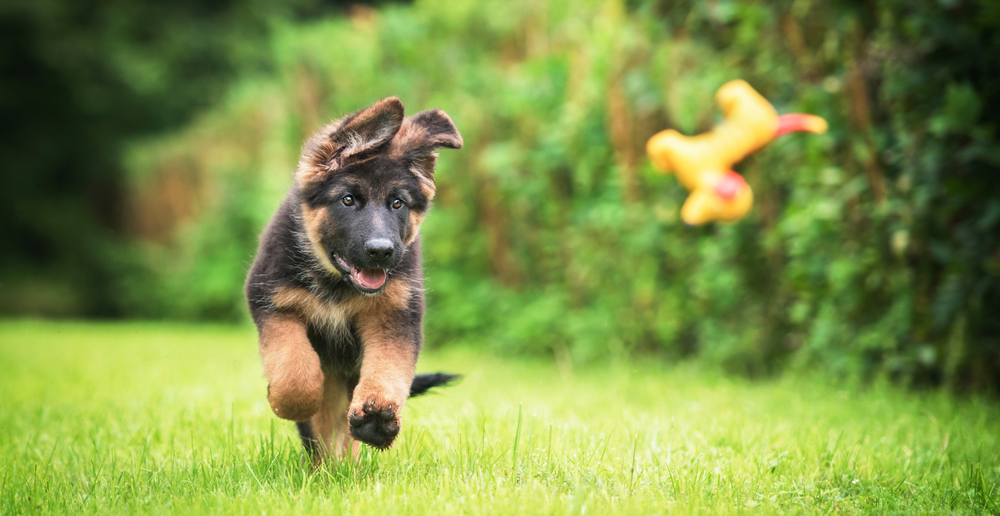Congratulations, new German Shepherd owner! You’ve welcomed such a wonderful breed into your family. Get ready for fellow German Shepherd owners to seek you out in public to admire your adorable pup and tell you all about their own.
And, get ready for a puppy that is going to grow a seemingly impossible amount in a short period of time. With a young GSD, it can seem like every time you blink, that pup has gained a couple of pounds and is suddenly a few inches taller. It really takes you by surprise.
So, how are you supposed to feed this growing fluff ball? We’re going to break down everything you need to know about feeding your pup, from protein levels to picking out the best dog food for your German Shepherd.
And, of course, you’ve got to know how much to feed the little one. We’ve broken it down for you so that you know exactly how much to feed and when to start feeding more.
Let’s jump right in!

Special Considerations for German Shepherds
These are big dogs. And with big dogs, the growing period is crucial. Too little nutrition, and the bones struggle to develop. Too much food, too fast, and they’ll grow too quickly for the bones to develop properly, leading to common issues like hip dysplasia.
What you want for your German Shepherd puppy is slow, steady, healthy growth.
Protein, protein, protein
For dogs to develop big and strong, you want them to have the right level of protein in their diet. For a highly active, strong dog like the German Shepherd, you want something that’s going to be at least 22% protein.
With younger pups, this number should be even higher. Good quality puppy foods should contain somewhere around 33% protein.
How to Choose The Best Dog Food for German Shepherd Puppies
There are a lot of options on the market that you can feed your German Shepherd puppy. Some experts recommend a high-quality organic dry food. Some trust in wet, canned foods. Others suggest making dog food at home from all-natural ingredients.
Whatever option you choose, the most important – and obvious – consideration is going to be the ingredients. You want high-quality ingredients that are safe for dogs to eat. A lot of the brands on the market contain harmful preservatives and fillers, so make sure you research each brand to learn about the ingredient list.
Also, you’ll want food that isn’t too high in fat. Although fat is an important ingredient that contributes to your GSD’s health, you don’t want to feed them a diet with more than 8% fat.
Make sure to check in with your puppy’s veterinarian to get the okay on whatever food you’re thinking of feeding the little one. After all, there are a few other things, like phosphorous and calcium, that a growing pup needs. And a vet will be able to tell you if your food choice is meeting those needs.
Here are some pros and cons of a few different dog foods:
Dry Food
This is the most common dog food on the market. That’s because it’s convenient, long-lasting, and widely available. Here’s some more information on dry foods:
- Pros: convenient (no preparation needed), long-lasting (doesn’t need to be stored in the fridge), and widely available. Some dry foods are designed for dental hygiene and teeth-cleaning
- Cons: Devoid of hydration, often filled with unhealthy fillers, lower levels of protein
Wet Food
There are many kinds of wet food available, today, and some are better than others. In general, here’s the breakdown for we foods:
- Pros: hydrating, higher protein content (not all! It’s important to check the label), more appealing to many dogs (especially older dogs who struggle with a sense of smell), easier to eat and digest (good for puppies)
- Cons: not as convenient as dry food, needs to be refrigerated after opening, not as long as a shelf-life as dry foods
Homemade Diet
This is a relatively recent trend, but it’s becoming more popular all the time. Here are the pros and cons:
- Pros: you have more control over what’s in your dog’s food, fresher ingredients, potential to be more protein-rich, potential to have more healthy fats
- Cons: labor-intensive, requires extensive research, not lab-tested
The important thing to remember about a homemade diet is that you are solely responsible for your dog’s health, including calculating the protein-fat-carb ratios and ensuring that they get enough nutrients. It’s important to talk to a vet if this is something you’re considering for your German Shepherd puppy.
How often do you feed a puppy?
 Alright, once you bring your adorable bundle of barks home, how much should be you feeding? Well, ultimately, it depends on the recommendation that you can find on the label of your dog food. That’s because different dog foods will contain different amounts of calories per cup.
Alright, once you bring your adorable bundle of barks home, how much should be you feeding? Well, ultimately, it depends on the recommendation that you can find on the label of your dog food. That’s because different dog foods will contain different amounts of calories per cup.
But, here’s a pretty generalized chart of how much you can expect to feed your puppy at different stages of their development.
6 weeks
- Frequency: at this stage, puppies should be eating 3 to 4 times per day.
- Amount: 2 cups per day
- Expected weight (between 4 and 6 weeks): 2lbs for females, 9.2lbs for males
Six weeks old is often the time when a German Shepherd puppy will stop feeding with mom. Because a mother’s milk is so nutritious, though, some owners will opt to continue nursing until 8 weeks old. This will ensure a healthy pup.
Still, your pup is old enough to start eating wet food or dry food that has been soaked in water.
8 weeks
- Frequency: 3 to 4 times per day
- Amount: Between 2 and 2 and a half cups
- Expected Weight: 16lbs for females, 19lbs for males
12 weeks
- Frequency: 3 to 4 times per day
- Amount: 3 and a half to 4 cups
- Expected Weight: 27lbs for females, 31lbs for males
At this stage, you can start transitioning your pup from a wet food (or soaked dry kibbles) to dry food.
4 Months
- Frequency: 3 times per day
- Amount: 4 and ? to 4 and ¾ cup
- Expected Weight: 36lbs for females, 41lbs for males
5 Months
- Frequency: 2 to 3 times per day
- Amount: 4 to 5 cups
- Expected Weight: 44lbs for females, 51lbs for males
6 Months
- Frequency: 2 to 3 times per day
- Amount: 5 to 6 cups
- Expected Weight: 50lbs for females, 57lbs for males
8 Months
- Frequency: 2 times per day
- Amount: 5 to 6 cups
- Expected Weight: 57ls for females, 66lbs for males
10 Months
- Frequency: 2 times per day
- Amount: 5 to 6 cups
- Expected Weight: 61lbs for females, 72lbs for males
1 year
- Frequency: 2 times per day
- Amount: 6 cups, possibly lowering to 5 cups or 4 and ½ cups
- Expected Weight: 64lbs for females, 76lbs for females
At this point, your little one is not so little anymore. In fact, they’ve likely reached about 80% of their adult weight, and their growth will slow significantly from here on out. Over the next couple of years, they will fill out to their full size.
Other Considerations
Everything that we’ve discussed so far has had to do with hard numbers and percentages. But, just like every person is different, every puppy is different, too. Your German Shepherd is going to have slightly different metabolism and growth rate than others.
So, think of these facts as a starting point. Here’s a simple way that you can monitor whether you’re giving your dog the right amount of food at each stage:
- You can see the outline of the ribs when you see your dog from the side, but not so much so that they seem to be protruding
- From above, you can see your dog’s defined waist, but the pelvic bones are not visible
Generally, you’ll be able to tell if your pup is too skinny if it feels like there’s just not enough tissue between their skin and bones.
You can also tell if a puppy is getting enough to eat by their general happiness and energy levels. A pup that is not getting enough food will be sluggish and less willing to play, which is definitely a bad sign!
Find the best puppy food routine for your German Shepherd
As you can see, there are a lot of factors that go into finding the perfect feeding routine
for your brand new German Shepherd pup. Remember to check in with a vet to make sure your puppy is getting enough nutrition, and don’t forget to give your new family member plenty of love!




